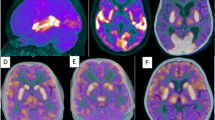Abstract
Striatal hypermetabolism on 18FDG-PET scan is a neuroradiological finding that has been described in association with autoimmune disorders such as Sydenham chorea, lupus or antiphospholipid syndrome. Here, we report three patients with non-paraneoplastic limbic encephalitis characterized by 18FDG-PET hypermetabolism of both striata, in contrast with diffuse hypometabolism in the rest of the brain. All patients developed subacute dementia, and antibodies to voltage-gated potassium channels were found in all cases. Brain metabolism and neurological status improved within a few months of immunosuppressive therapy. The finding of striatal hypermetabolism on 18FDG-PET images could thus be highly indicative of limbic encephalitis associated with anti-neuropil antibodies. It could be of significant help in the diagnosis of this rare and treatable condition, and may also provide a useful marker of disease outcome.

Similar content being viewed by others
References
Corsellis JA, Goldberg GJ, Norton AR (1968) “Limbic encephalitis” and its association with carcinoma. Brain 91(3):481–496
Bataller L, Kleopa KA, Wu GF et al (2007) Autoimmune limbic encephalitis in 39 patients: immunophenotypes and outcomes. J Neurol Neurosurg Psychiatry 78(4):381–385
Buckley C, Oger J, Clover L et al (2001) Potassium channel antibodies in two patients with reversible limbic encephalitis. Ann Neurol 50(1):73–78
Sansing LH, Tüzün E, Ko MW et al (2007) A patient with encephalitis associated with NMDA receptor antibodies. Nat Clin Pract Neurol 3(5):291–296
Bataller L, Galiano R, García-Escrig M et al (2010) Reversible paraneoplastic limbic encephalitis associated with antibodies to the AMPA receptor. Neurology 74(3):265–267
Vincent A, Buckley C, Schott JM et al (2004) Potassium channel antibody-associated encephalopathy: a potentially immunotherapy-responsive form of limbic encephalitis. Brain 127(3):701–712
Lancaster E, Lai M, Peng X et al (2010) Antibodies to the GABA(B) receptor in limbic encephalitis with seizures: case series and characterisation of the antigen. Lancet Neurol 9(1):67–76
Titulaer MJ, Soffietti R, Dalmau J et al (2011) Screening for tumours in paraneoplastic syndromes: report of an EFNS task force. Eur J Neurol 18(1):19 e3
Bartenstein P, Asenbaum S, Catafau A et al (2002) European Association of Nuclear Medicine. European Association of Nuclear Medicine procedure guidelines for brain imaging using [(18)F]FDG. Eur J Nucl Med Mol Imaging 29:43–48
Folstein MF, Folstein SE, McHugh PR (1975) Mini-mental state—a practical method for grading the cognitive state of patients for the clinician. J Psychiatr Res 12(3):189–198
Fauser S, Talazko J, Wagner K et al (2005) FDG-PET and MRI in potassium channel antibody-associated non-paraneoplastic limbic encephalitis: correlation with clinical course and neuropsychology. Acta Neurol Scand 111(5):338–343
Ances BM, Vitaliani R, Taylor RA et al (2005) Treatment-responsive limbic encephalitis identified by neuropil antibodies: MRI and PET correlates. Brain 128(8):1764–1777
Chatzikonstantinou A, Szabo K, Ottomeyer C et al (2009) Successive affection of bilateral temporomesial structures in a case of non-paraneoplastic limbic encephalitis demonstrated by serial MRI and FDG-PET. J Neurol 256(10):1753–1755
Scheid R, Lincke T, Volltz R et al (2004) Serial 18F-Fluoro-2-deoxy-d-glucose positron emission tomography and magnetic resonance imaging of paraneoplastic limbic encephalitis. Arch Neurol Nov 61(11):1785–1789
Goldman S, Amrom D, Szliwowski HB (1993) Reversible striatal hypermetabolismin a case of Sydenham’s chorea. Mov Disord 8(3):355–358
Furie R, Ishikawa T, Dhawan V et al (1994) Alternating hemichorea in primary antiphospholipid syndrome: evidence for contralateral striatal hypermetabolism. Neurology 44(11):2197–2199
Krakauer M, Law I (2009) FDG PET brain imaging in neuropsychiatric systemic lupus erythematosis with choreic symptoms. Clin Nucl Med 34(2):122–123
Léger GC, Johnson N, Horowitz SW et al (2004) Dementia-like presentation of striatal hypermetabolic state with antistriatal antibodies responsive to steroids. Arch Neurol 61(5):754–757
Kramer EL, Sanger JJ (1990) Brain imaging in acquired immunodeficiency syndrome dementia complex. Semin Nucl Med 20(4):353–363
Rottenberg DA, Sidtis JJ, Strother SC et al (1996) Abnormal cerebral glucose metabolism in HIV-1 seropositive subjects with and without dementia. J Nucl Med 37(7):1133–1141
von Giesen HJ, Antke C, Hefter H et al (2000) Potential time course of human immunodeficiency virus type 1-associated minor motor deficits: electrophysiologic and positron emission tomography findings. Arch Neurol 57(11):1601–1607
Sathekge M, Goethals I, Maes A, van de Wiele C (2009) Positron emission tomography in patients suffering from HIV-1 infection. Eur J Nucl Med Mol Imaging 36(7):1176–1184
Ho DD, Bredesen DE, Vinters HV et al (1989) The acquired immunodeficiency syndrome (AIDS) dementia complex. Ann Intern Med 111:400–410
Vincent A, Lily O, Palace J (1999) Pathogenic autoantibodies to neuronal proteins in neurological disorders. J Neuroimmunol 100(1–2):169–180
Irani SR, Michell AW, Lang B et al (2011) Faciobrachial dystonic seizures precede Lgi1 antibody limbic encephalitis. Ann Neurol 69(5):892–900
Baron JC, Levasseur M, Mazoyer B, Legault-Demare F, Mauguiére F, Pappata S, Jedynak P, Derome P, Cambier J, Tran-Dinh S et al (1992) Thalamocortical diaschisis: positron emission tomography in humans. J Neurol Neurosurg Psychiatry 55(10):935–942
Baron JC, Serdaru M et al (1986) Cortical hypometabolism after a thalamic lesion in man: positron tomography study. Rev Neurol (Paris) 142(4):465–474
Pawlik G, Beil C, Herholtz K et al (1985) Comparative dynamic FDG-PET study of functional deactivation thalamic versus extrathalamus focal ischemic brain lesions. J Cereb Blood Flow Metabol 5(suppl 1):S9–S10
Conflict of interest
None.
Author information
Authors and Affiliations
Corresponding author
Rights and permissions
About this article
Cite this article
Rey, C., Koric, L., Guedj, E. et al. Striatal hypermetabolism in limbic encephalitis. J Neurol 259, 1106–1110 (2012). https://doi.org/10.1007/s00415-011-6308-2
Received:
Revised:
Accepted:
Published:
Issue Date:
DOI: https://doi.org/10.1007/s00415-011-6308-2




